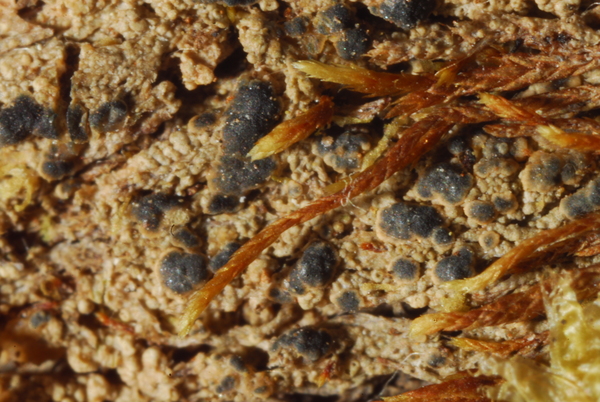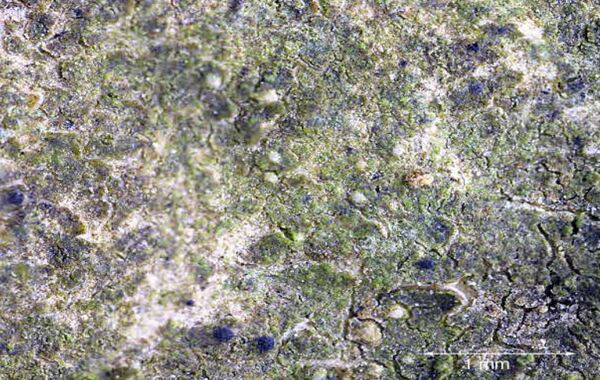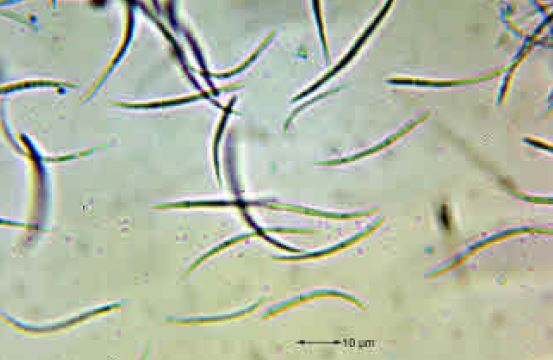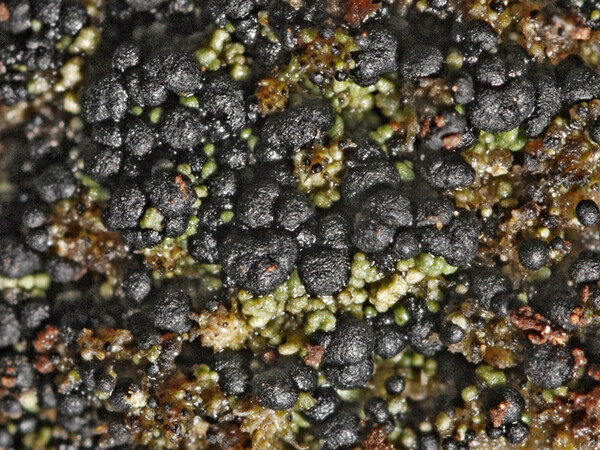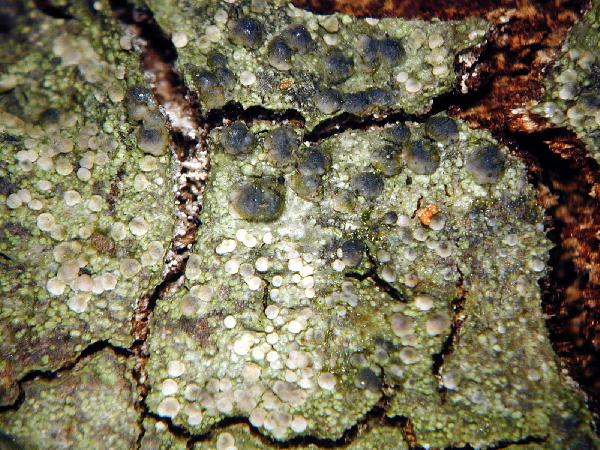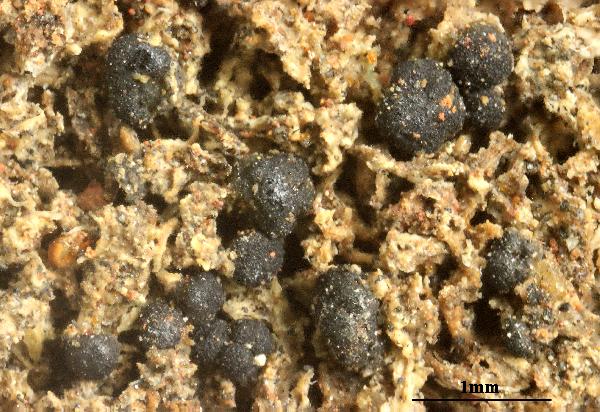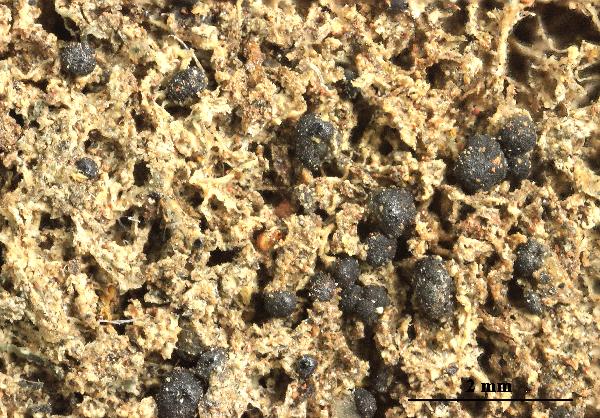Micarea peliocarpa (Anzi) Coppins & R. Sant.
in Coppins & James, Lichenologist, 11: 155, 1979. Basionym: Bilimbia peliocarpa Anzi - Atti Soc. Ital. Sc. Nat. Milano, 9: 250, 1866.
Synonyms: Bacidia albidolivens (Nyl.) Zahlbr.; Bacidia hemipolioides (Nyl.) Zahlbr.; Bacidia peliocarpa (Anzi) Lettau; Bacidia trisepta (Nägeli) Zahlbr.; Bacidia triseptatuloides (Harm.) Zahlbr.; Bacidia violacea (P. Crouan & H. Crouan ex Nyl.) Arnold; Bilimbia albicans Arnold; Bilimbia hemipolioides (Nyl.) A.L. Sm.; Bilimbia subviridescens var. trisepta (Nägeli) A.L. Sm.; Bilimbia trisepta (Nägeli) Hellb.; Lecidea albidolivens Nyl.; Lecidea fraterculans Nyl.; Lecidea hemipolioides Nyl.; Lecidea triseptatula Nyl.; Lecidea triseptatuloides Harm.; Lecidea violacea P. Crouan & H. Crouan ex Nyl. non A. Massal. nom. illegit.; Micarea trisepta (Nägeli) Wetmore; Micarea violacea (P. Crouan & H. Crouan ex Nyl.) Hedl.
Distribution: N - Frl, Ven (Brackel 2013), TAA (Hinteregger 1994, Nascimbene & al. 2007b, 2022, Nascimbene 2008b, Nimis & al. 2015), Lomb, VA (Piervittori & Isocrono 1999), Emil (Nimis & al. 1996, Tretiach & al. 2008, Fariselli & al. 2020), Lig (GE 145). C - Tosc (Benesperi & al. 2007), Umb (Ravera 2000, Ravera & al. 2006), Sar (Zedda 2002). S - Cal (Puntillo 1995, 1996), Si (Nimis & al. 1994).
Description: Thallus crustose, usually episubstratic, greenish white to blue-grey, of moderately to strongly convex, to 0.2 mm wide areoles, sometimes almost continuous but more or less cracked, rarely endosubstratic and poorly evident. Apothecia micareoid, rounded, sessile, not constricted at base, sometimes confluent and tuberculate, flat to convex, 0.15-0.7(-1) mm across, variously coloured, from completely whitish to greyish, lead-grey, grey-brown, blackish or black, or often piebald or bluish tinged, at first usually with a slightly paler margin, but later mostly immarginate. Proper exciple up to 50(-60) μm wide, colourless to straw-coloured, composed of densely branched and anastomosing, 1.8-2.5 μm wide, paraphysis-like hyphae; epithecium scarcely differentiated from the hymenium; hymenium 40-55 μm high, colourless, but in upper part slightly olivaceous straw-coloured, greyish-green to aeruginose-green in darker apothecia, K± greenish intensifying, C+ fleeting orange-red, N+ red,; paraphyses conglutinated, branched and anastomosing, 1-1.5 µm thick at mid-level, the apical cells to 2.5 µm wide; hypothecium more or less colourless or pale yellow, 50-70 μm high. Asci 8-spored, clavate, in K/I with a blue outer layer and apical dome and unstained wall, the dome with an apical cushion, (25-)35-45(-50) x 12-15 μm. Ascospores (1-)3(-5)-septate, hyaline, fusiform-elongate, often slightly curved, (11-)15-23(-24) x 3-5(-6) μm. Pycnidia often present, of two types: a) small, 30-70 μm wide, immersed to ±sessile, whitish to dark olivaceous-green, producing thread-like to narrowly baciliform microconidia measuring 5-7.5(-8) x 0.4-0.7(-0.9) μm; b) immersed, 120-150 μm wide, often widely gaping, concolour with thallus around ostioles or greenish producing usually strongly curved, sometimes sigmoid, rarely also straight, mostly 3-septate macroconidia measuring 16-38(-50) x (1-)1.2-1.5(-1.7) μm; pycnidial walls C+ fleeting orange red, K- or K+ intensifying green when pigmented. Photobiont micareoid, the cells 4-8 μm wide. Spot tests: thallus and apothecial sections K-, C+ red, KC+ red, P-. Chemistry: gyrophoric acid. Note: a temperate to boreal-montane, ecologically wide-ranging species found on the acid bark of deciduous (especially old oaks and Fagus) and coniferous trees, lignum, peaty soil, moribund bryophytes, and small siliceous pebbles.
Growth form: Crustose
Substrata: bark, lignum, rocks, soil, terricolous mosses, and plant debris
Photobiont: green algae other than Trentepohlia
Reproductive strategy: mainly sexual
Commonnes-rarity: (info)
Alpine belt: absent
Subalpine belt: rare
Oromediterranean belt: rare
Montane belt: rather rare
Submediterranean belt: very rare
Padanian area: absent
Humid submediterranean belt: very rare
Humid mediterranean belt: absent
Dry mediterranean belt: absent

Predictive model
Herbarium samples
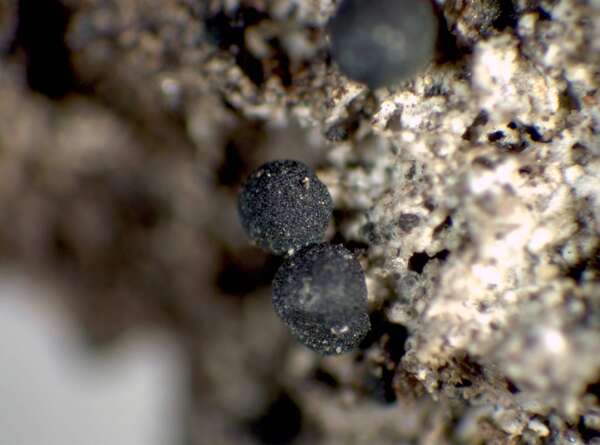

P.L. Nimis; Owner: Department of Life Sciences, University of Trieste
Herbarium: TSB (29580)
2001/12/10


Felix Schumm - CC BY-SA 4.0
[ABL50717], Brazil, Amazonas, Manaus, Reserva Florestal Ducke,
along trails in vincity of field station, in primary tropical rain forest on
tree bark. 2°56' S, 59°57' W, 50 m. Leg. A. Aptroot, (no. 50717), 22.
June 2019, det. A. Aptroot 2019
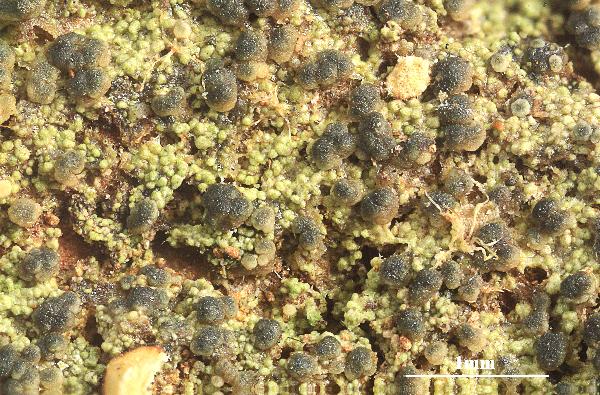

Felix Schumm - CC BY-SA 4.0
[ABL50717], Brazil, Amazonas, Manaus, Reserva Florestal Ducke,
along trails in vincity of field station, in primary tropical rain forest on
tree bark. 2°56' S, 59°57' W, 50 m. Leg. A. Aptroot, (no. 50717), 22.
June 2019, det. A. Aptroot 2019
Growth form: Crustose
Substrata: bark, lignum, rocks, soil, terricolous mosses, and plant debris
Photobiont: green algae other than Trentepohlia
Reproductive strategy: mainly sexual
Commonnes-rarity: (info)
Alpine belt: absent
Subalpine belt: rare
Oromediterranean belt: rare
Montane belt: rather rare
Submediterranean belt: very rare
Padanian area: absent
Humid submediterranean belt: very rare
Humid mediterranean belt: absent
Dry mediterranean belt: absent

Predictive model
| Herbarium samples |


P.L. Nimis; Owner: Department of Life Sciences, University of Trieste
Herbarium: TSB (29580)
2001/12/10


Felix Schumm - CC BY-SA 4.0
[ABL50717], Brazil, Amazonas, Manaus, Reserva Florestal Ducke, along trails in vincity of field station, in primary tropical rain forest on tree bark. 2°56' S, 59°57' W, 50 m. Leg. A. Aptroot, (no. 50717), 22. June 2019, det. A. Aptroot 2019


 INDEX FUNGORUM
INDEX FUNGORUM
 GBIF
GBIF
 DOLICHENS
DOLICHENS

